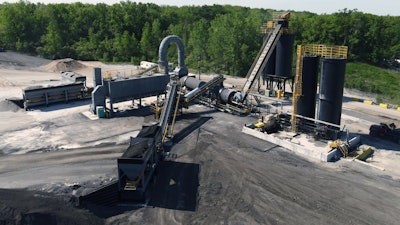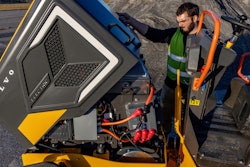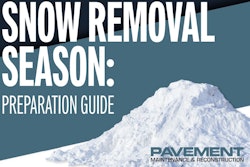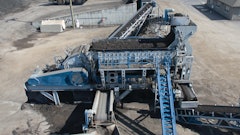
Offseason plant maintenance is a critical process in the road to a successful and busy paving season. When things heat up, suppliers and contractors can't afford to lose precious time with breakdowns and machine down-time. Of course, you can't guarantee with absolute certainty those things wont happen, but what proper offseason maintenance does do is ensure you've done everything in your power to make operations run as smoothly as possible.
There are a lot of available resources for regular offseason maintenance, including articles here at ForConstructionPros, like this one from former Editor Jessica Lombardo in 2020, that excellently covers the important essentials. In this article we reached out to some industry manufacturers to share with us what are the often overlooked, missed, and/or less common aspects of offseason maintenance that are easy to pass-over, but just as vital to stay on top of.
Baseline Visual Inspections and Winter Preparations
There's a lot of basic items that you can check off your list simply by taking a walk around, using common sense, and checking for some of these points. Visual indicators of maintenance needs are some of the easiest ways to know when and where work needs to be performed. If you see something, take action, and don't put things off. It is all too easy to put something in the back of your mind for later, and then later never comes. That might result in costly consequences.
According to Daniel Francisco, Vice President of Service and Construction Service at Astec, "Routine plant inspections are the key to building and maintaining a preventative maintenance program. When performing these inspections pay close attention to any visible signs of wear to the metal of your equipment caused by aggregate contact. These contact areas are where the aggregate slides, oscillates, scrubs, or impacts the metal surfaces." Ammann
Ammann
It's difficult when your in the busy days of the paving season to check on these potential wear-points, but in the slower colder months there should be adequate time to closely inspect your equipment. Year over year, you could even start taking pictures of the same important areas. This catalogue could be extremely useful in tracking visual changes that are harder to notice and recall on memory alone.
The service department from Asphalt Drum Mixers (ADM) said that, "Exhaust stack opacity should be checked, and if discolored, correct. Then review scale calibrations, and if you notice the scales are out, calibrate them immediately. If drag chain tensions are loose, adjust them as needed, as well as conveyor belt tracking & tension. Drum tracking can also need some checking and regular adjustment."
John Hynes, Service Department Manager for Gencor Industries, shared a few checklist items that are a smart starting point ahead of frigid winter temperatures rolling in your area:
- Place grease and shrink wrap plastic around exposed metal such as air cylinder rams, motor shafts and other components.
- Portable plant cable should be coiled up and placed on plywood then covered with tarps.
- Underground wires should be removed from areas near trapped sources of water, and sealed off from snow and ice build up around openings.
- Equipment junction boxes should have small weep-holes drilled in the bottom to prevent condensation from accumulating inside of them.
- Gearboxes and equipment that have large airspaces should be drained of oil and a corrosion inhibitor applied, such as VCI-105 oil by Daubert Chemical Company or similar product (this oil VCI-105 does not need drained at start up).
- Make sure the drain in exhaust fan bottoms are clean and open to drain.
- Place a cover over the hot oil heater stack.
Headaches and Pain Points
There's always parts of maintenance that are downright avoided, for one reason or another, they are a major headache. Maybe they are time consuming. Maybe they require a lot of careful attention. Or, perhaps, they are just a complete "pain in the ass". The result is that they get pushed to the back of the line, they get set on the back burner, and saved for last.
When that happens enough times, it can inevitably mean that they don't get done at all. Before too long, it might spell unexpected down time, repair costs, and lost revenue. It's called the "gutter effect", as in, if you don't clean out the gutters on your home, eventually you will pay the price. Better to bite the bullet, and get these done sooner, rather than later. Astec Industries
Astec Industries
Astec's Francisco reported a few of these to us, "The drum, drag/traverses, and silos are the most difficult areas to perform maintenance on. The maintenance of these areas of the plant is often planned for winter maintenance or scheduled shutdowns. Delaying the needed maintenance in these areas will lead to significant downtime, loss of production, and safety concerns."
ADM's service department said that, "It's definitely bearing lubrication. To predict when the bearing will fail is difficult. When the bearing does fail, the down time or as some say the 'lost time' will be a major issue."
"Before the winter shut down," according to Gencor's Hynes, "while the plant is operational at highest capacity, a list of equipment on the plant should be available to record bearings, gear box and motor temps at their normal levels as a reference to later use when getting ready to shut down for the winter."
In addition to that, Gencor added this list of common pain point items:
- Use a thickness gauge on silo sidewalls and cones.
- Drum shell should also be checked for thickness.
- Test new components purchased as spares to be sure they work before storing for future use—never assume that because it is new it will not fail.
Tips For Building A Maintenance Program
If you don't already have a regularly scheduled maintenance program, whether for the off-season specifically or not, it is a good idea to get one planned and implemented as soon as possible. As Carlos Machado, Business Development Manager from Ammann, notes, "Asphalt plant maintenance is always a hot topic between operators and the service team. Proper executive of the maintenance plants allows customers to get the most out of their products."
He notes that Ammann offers control systems solutions and integrated maintenance management systems for their products that, "Registered, structured and visualized directly in the control system screen. The maintenance tasks are supported with fixed periods of time, which can be scheduled based on the operating hours or on the material quantities processed in the plant."
It also includes dynamic messaging notifications to let operators know then it's time to perform certain tasks, as well as the possible risks of not doing them promptly.
"If you are not using a software based system," ADM said, "Reference the manufacturers equipment manuals regularly, and then install an hour meter, if one was not already provided, and schedule all work required accordingly. Not just off-season but daily, biweekly, monthly, and yearly maintenances are also in the manuals." And it's good to know that most manufacturer specific manuals and schedules can be found online, or by calling your plant manufacturer's customer service department, as well. ALmix
ALmix
Hynes adds that, "Recordation over the course of time for each plant will determine when maintenance is needed. When you have an issue, record how old the part was, what you replaced it with, and when it might need to be replaced again. Over time you will have a list of when and what fails on your plant."
Putting your plan in place is also a function of the various other operations and demands on the job, so, as Francisco said, "Prioritize each of these events and estimate the required manpower, parts, and time needed to complete each task. Document and record the maintenance you perform, this data collection will allow you to analyze and improve your maintenance program overtime."
Tracking all of these things is vital. Knowing what has happened will help you know what will happen in the future, and being able to predict the future is the key to avoiding catastrophic failures. We asked the experts what are some the most common types of failures they encounter when dealing with their customers, when breakdowns have occurred.
Hynes said, "Trunnion adjustments should be monitored over the season. Any sign of flaking or other difference in the appearance of the tire or trunnion should be addressed asap."
"Bearing and gearbox failures are common failures at facilities that do not practice routine maintenance," Francisco told us. "These types of failures can easily be overcome, though, by establishing a robust maintenance program."
According to ADM's team, the most common thing they come across is that the programs themselves are simply underdeveloped, insufficient, and the people in charge of them exhibit a sense of disregard for maintenance. That's a bad sign. If a facility has the “Run it until it breaks mentally”. The cost of unplanned and/or emergency repairs due to the lack of maintenance will typically cost a minimum of 50% more than proactive measures. Being proactive minimizes untimely breakdowns and reduces the hectic nature of reactive repairs.
Simple and Still Important
Not everything that falls under your maintenance plan will be at the top of the priority list. Not everything should or can be equally as important, that wouldn't be a good list. It need to be organized in such a way that you can plan around the job's importance and critical nature to production and smooth operations. By this logic, what are some of those bottom-of-the-list items that still should receive your attention once the top hitters are taken care of. What things can put your plant over the top?
"Some people may not consider this to be maintenance," Francisco said, "but good housekeeping around the facility is simple and is often overlooked. Good Housekeeping practices enable maintenance personnel to quickly pinpoint potential problem areas and it establishes a safer work environment."
ADM's team said that it's, "Lubrication and Lubrication type. So many will purchase the lesser expensive lubrication, a one-type-fits-all type and then experience bearing failures down the road."
Hynes told us that, "Paint peeling or burnt looking areas at the stack of the drum happens due to vailing inside the drum and indicates the need for flighting upgrade or positioning.
No matter where your current maintenance plan is, it is never a bad idea to take a fresh look at it and review possible improvements, changes and ideas to make it even better. Take this offseason and make it the year your team is the most prepared for the spring they've ever been.






![2023 Top 30 Asphalt Contractor Logo[78]](https://img.forconstructionpros.com/files/base/acbm/fcp/image/2022/12/2023_Top_30_Asphalt_Contractor_Logo_78_.638a68aa251f2.png?auto=format%2Ccompress&fit=crop&h=167&q=70&rect=69%2C0%2C1779%2C1002&w=250)













